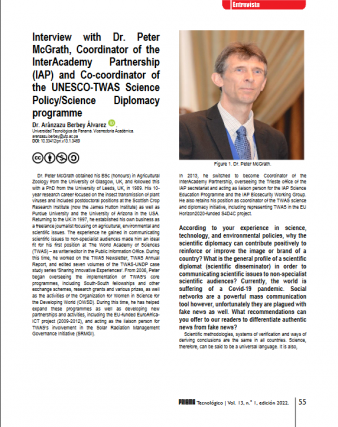Interview with Dr. Peter McGrath, Coordinator of the InterAcademy Partnership (IAP) and Co- coordinator of the UNESCO-TWAS Science Policy/Science Diplomacy programme
Q: According to your experience in science, technology, and environmental policies, why the scientific diplomacy can contribute positively to reinforce or improve the image or brand of a country? What is the general profile of a scientific diplomat (scientific disseminator) in order to communicating scientific issues to non - specialist scientific audiences? Currently, the world is suffering of a Covid-19 pandemic. Social networks are a powerful mass communication tool however, unfortunately they are plagued with fake news as well. What recommendations can you offer to our readers to differentiate authentic news from fake news?
Dr. Peter McGrath: Scientific methodologies, systems of verification and ways of deriving conclusions are the same in all countries. Science, therefore, can be said to be a universal language. It is also, therefore, a relatively easy way for countries to collaborate and to participate in regional or international programmes. Participation in such activities can help build ‘kudos’ for a country. Indeed, this is part of the essence of science diplomacy. However, it is not always easy for the scientific and policy communities to speak to one - another.
Having said that, there is a growing ‘space’ between the two communities where more and more people and organizations are operating, either as formal (linked to national governments) or inform all science diplomats. There is not set job description for these positions, and people operating in this space may or may not have scientific backgrounds, or backgrounds in diplomacy or international relations. What they do have in common is the ability to build networks and develop soft skills such as negotiation as well as – as you suggest – the ability to communicate scientific concepts to non-technical audiences. We have seen the value of such communication throughout the covid-19 pandemic – where government messaging based on references to scientific evidence communicated clearly to populations has been much more effective than garbled messages based on politically-motivated half-truths – or worse.
Of course there are still many ways of interpreting even clear messages when the science is still developing, as it is during the current pandemic, which can lead to falsehoods and fake news being amplified on social media. How should we react as scientists? First, before sharing anything on social media – make sure it is accurate. Here national academies of science and medicine can be useful as sources of trusted information. IAP has collated academy advice here: https://www.interacademies.org/project/academy-response-covid-19. Other websites such as https://shareverified.com/en/ can also be useful. We may also consider refuting fake news – but this must be done carefully, in a way that does not antagonize the original poster or his/her circle of social media contacts. We should seek to understand why they believe what they do, and then present facts – in a dialogue – to explain the evidence.
Click here to read the full interview.
